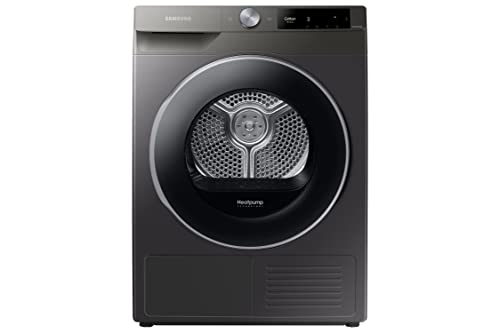Five Lessons You Can Learn From Heat-Pump Tumble Dryer

Heat-Pump Tumble Dryer
A tumble dryer with a heat pump is a great alternative to traditional vented and condenser models. It is more energy efficient, protects your clothes and the environment and costs less.
The smart system of these dryers repurposes the air throughout the cycle. The air that enters into the drum reheats, evaporating moisture and leaving your clothes with the cooled air.
Energy efficiency
A heat pump can do so much more than simply heat up a space. It can even provide cooling, and now it's tackling laundry, which is among the most energy-sucking appliances found in modern homes. And it's doing it using less power that traditional electric dryers consume.
The key is to transfer heat, not create it. Instead of relying on a heating element to evaporate the moisture inside the clothes, as in a conventional electric dryer, heat pump tumble dryers use an air compressor that transfers heat between two cycles. This is achieved by absorbing heat from the air around it and venting it, which then warms the cold air coming in. The cycle is repeated.
Electric heat pumps are more gentle on your clothes, as they operate at lower temperatures than vented dryers. Ventilated dryers operate at high temperatures which cause fabrics to shrink and necklines to become misshaped. This extends their life and helps your clothes keep their colors and prints.
The venting of vented tumble dryers isn't required. They can be vented outdoors using an water hose. Instead, they move heat from outside into a drum for drying that is filled with moist clothes. As the fabric spins, the heat moves to the drum which is heated to the same temperature as the room. The warm air evaporates water from the clothing and can be drained into the drain directly or collected in tanks.
The process is continuous, but when the cycle ends and the dryer exhausts, it draws in new air from outside, which is conditioned by your building's furnace or air conditioning system to cool and warm purposes. It replaces the conditioned air which is then ejected from the exhaust vent of the dryer. This means that you don't need to spend extra money conditioning outdoor air for your laundry.
This makes heat-pump dryers an excellent alternative for buildings that already have a heat pump to regulate indoor air. This is especially relevant for buildings that are trying to connect all indoor air systems under one control system. Once all the equipment is connected to the central system, you can set it up to make sure that the air that is conditioned from the central system in your building flows from one side of the building to the other and reduces the need for each appliance to work hard to condition new outdoor air for each washing or drying session.
Convenience
In a world that is becoming more conscious of our effect on the environment, choosing an appliance that minimizes the environmental footprint is a good idea. Tumble dryers with heat pumps are an excellent choice since they consume less energy than conventional models and help you live a greener lifestyle.
Unlike vented or condenser tumble dryers, which use hot air to evaporate moisture from the drum, heat pump models recycle the heat that they generate. Instead of venting outside, the warm air from the dryer's evaporator will be filtered and reabsorbed in a water tank. Then it will be heated again to repeat the cycle. This means there's no need for an exhaust pipe, and you can safely position the dryer anywhere within your home.
Furthermore they are kinder to your clothes, preventing shrinkage. They do this by using lower temperatures for drying that protect your clothing and extends their lifespan. They can be used to dry delicate wool sweaters and silk blouses.
To add to their convenience In addition, many heat pump tumble dryers come with a variety of smart features that make laundry day a breeze. From automatic timer settings to a clever connection to your Miele washing machine, they're designed to work with you and fit seamlessly into your daily routine.
Some heat pump dryers have a sensor which measures the amount of moisture that is on your clothes and adjusts the time of the cycle automatically. This helps prevent over-drying and extends the life of your clothes, while also reducing energy. Add-on programmes allow you to run a second laundry load while the primary one is getting done. You can also set an automated end of cycle alert to remind you to wash your clothes.

Heat pump dryers can be smaller than traditional vented or condenser dryers. This makes them more convenient to fit into small space. Their sleek designs are perfect for any modern design scheme. With a variety of colours and finishes, you are certain to find something that matches your home perfectly.
Cleaning
Like other tumble dryers, heat-pump models have a pair of fine lint screens as well as condenser coils that must be cleaned after each load. These parts can be easily removed and put back into the appliance. A heat-pump also comes with a two part fluff filter which should be opened, washed with soapy water or descaled on a regular basis to ensure it is working correctly.
You must clean the moisture sensor on the door of your appliance as often as you can. It can be affected by residues from detergents and other products for care. This will alter its function and cause slow drying. It is possible to do this by opening the door of the appliance and using a coarse sponge to thoroughly clean the sensor area. It should then be closed again.
Maintenance
Even the best tumble dryer won't provide dry and clean laundry if it's not maintained properly. Tumble dryers are prone to problems and can be expensive to repair, however regular checks and cleaning is easy and can save you money in the long in the long run.
If your tumble dryer is vented (expels warm and moist air through a hose out of your home) then cleaning the hose every three months is vital. The hose could become blocked with lint or other particles and reduce the airflow and make your dryer less efficient. Luckily, a venting hose is easy to clean and clear using a wet cloth or a vacuum cleaner fitted with brush attachment.
The lower filter of a heat pump tumble dryer is a bit more difficult to access, however it's still necessary to clean. It's located at the lower part of the machine, just in the front of the heat exchanger, and is usually locked by pressing two small levers upwards. Just rinse the filter, pick up bits of fluff and hair, and rinse until it is completely clear.
The tumble dryers that use a heat pump are more expensive than vented ones, which is why it's important to keep them free of filth and ensure they continue to perform well. This will also reduce the cost of energy.
You should also check the condition of the belt that rotates the drum inside the tumble dryer. If you hear it squealing, or notice that it's moving slower than usual, it could be a sign of that there is a problem with the belt.
Another maintenance tip is to ensure that the fine mesh filter is free from lint. It's often hard to see but it is important to check it regularly. A blocked filter could cause your dryer to take longer to dry, and could cause leakage of water. It is also essential to ensure that the heat exchanger doesn't get clogged by particles. If tumble dryer with heat pump don't empty your reservoir at the end of every cycle, or if there is too much laundry in a cycle, you may hear a buzzing or beeping to remind you to empty it.
